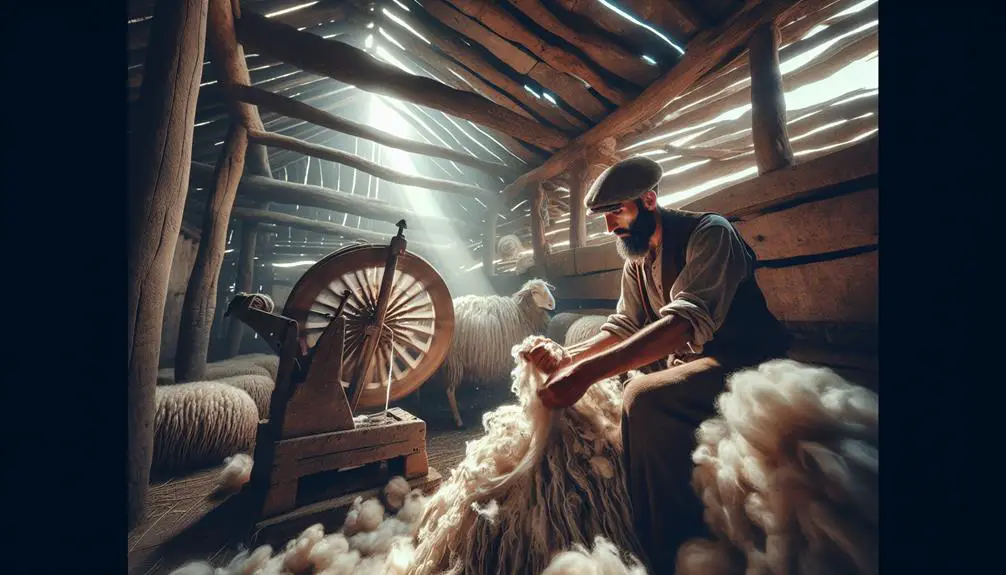I shear sheep once a year to get their fleece, weighing 6 to 18 pounds. It's good for the sheep and makes wool for different products. Wool is categorized as woollen or worsted depending on the quality. Lanolin is taken from wool by washing it. Worsted wool is strong and smooth, made by selecting fine fibers. Comb and spin wool fibers to make worsted yarns. For woollen wool, blend, scour, and card the fibers. These steps prepare the wool for spinning. Fabric production includes weaving and dyeing. Finish wool products carefully. Learn more about wool making process.
Table of Contents
Key Takeaways
- Sheep shearing is done annually using electric clippers.
- Wool classified as woollen or worsted based on processing.
- Lanolin extracted from wool has various industrial uses.
- Worsted processing involves fiber selection and spinning.
- Woollen processing includes scouring and blending for quality wool.
Sheep Shearing
Shearing sheep is the essential process of carefully removing wool from their bodies, typically carried out once a year by skilled shearers using electric clippers. This technique guarantees that the sheep are relieved of their heavy fleece, promoting their well-being. The fleece obtained from shearing can weigh between 6 to 18 pounds, depending on the breed of the sheep. It's important to shear the sheep properly to prevent them from overheating or experiencing discomfort due to the weight of the wool.
The wool gathered from shearing serves as a crucial raw material for producing various wool products. This natural fiber is essential and can be used to create clothing, blankets, carpets, and many other items. The quality of the wool depends on factors such as the sheep's diet, environment, and breed. Skilled shearers play a significant role in guaranteeing that the wool is harvested efficiently and without causing harm to the sheep.
Wool Classification
When categorizing wool, it's important to distinguish between woollen and worsted types based on the processing techniques and quality of the fibers utilized. Woollen wool is created from shorter fibers, resulting in soft and fuzzy fabrics ideal for winter clothing. On the other hand, worsted wool utilizes longer, finer fibers, producing smoother and more durable fabrics. The quality of the wool plays a significant role in determining the classification and characteristics of the final products. Woollen fabrics are known for their warmth and bulkiness, while worsted fabrics are more refined and lightweight.
Distinct processing methods are employed for woollen and worsted wool, such as carding, combing, and spinning. These techniques help align the fibers, eliminate impurities, and create yarn suitable for weaving or knitting. Understanding the classification of wool is essential in deciding the type of fabric to be manufactured and the intended use of the final woollen or worsted product.
Lanolin Extraction
Extracting lanolin from sheep's wool involves washing the fleece in hot water and detergent to remove the natural wax that serves as a protective layer. This process is essential during wool processing as lanolin is a valuable substance with various industrial and pharmaceutical applications.
After washing, the lanolin-rich water is separated from the wool fibers using centrifugal force. The extracted lanolin is then further refined through a process known as lanolin refining. This refining stage is vital for producing high-quality lanolin that can be used in cosmetic-grade products like moisturizers and lip balms.
It's fascinating how this natural wax, which initially protects the sheep's wool, can be transformed into a versatile ingredient with numerous beneficial uses. Through lanolin extraction and refining, the wool industry not only obtains valuable byproducts but also contributes to the production of a range of everyday items.
Worsted Processing
I'll now talk about the Worsted Processing phase in making wool.
This part involves carefully selecting the fibers, then combing and drafting them to align for a smooth finish.
Fiber Selection Process
During worsted processing, the careful selection of long wool fibers plays an essential role in ensuring the quality and strength of the final product. High-quality wool fibers are chosen to create smooth and durable worsted fabrics. This fiber selection process is vital for producing fine worsted yarns.
Combing and Drafting
Efficiently aligning and parallelizing fibers, combing in worsted processing eliminates short fibers and impurities to produce a smooth, high-quality yarn top. During combing, the fibers are carefully straightened and arranged in a uniform manner, ensuring a consistent yarn quality.
Additionally, drafting plays an important role in worsted processing by reducing the thickness of the top, making the fibers more aligned for the spinning process. This step is essential in creating yarn with the desired characteristics, such as strength and evenness.
Spinning Yarn Strand
In worsted processing, spinning yarn strands involves extending roving into a continuous yarn with added twist, typically utilizing ring spinning techniques in the industry.
Roving, which thins the wool top into a fine sliver, plays an essential role before spinning, ensuring the resulting worsted yarn is consistent and of high quality. This process follows carding, where locks and clumps of wool are untangled, fibers are aligned, and any impurities like vegetable matter are removed.
Worsted spinning aims to create durable, fine yarns suitable for high-end textiles and garments, as it's spun from high-quality fleece wool with long fibers. The resulting worsted yarn produces flatter, lighter, and smoother fabrics, ideal for tailoring purposes.
Woollen Processing
To process wool into yarn, we start by blending different wool batches to guarantee consistent quality throughout the production. Blending involves combining wool from various bales to ensure uniform characteristics.
After blending, the wool undergoes scouring, a vital step that removes contaminants such as dirt, wool wax, salts, and non-wool protein. This is achieved by washing the fibers in a detergent solution, leaving the wool clean and ready for further processing.
In woollen processing, carbonising is another essential process. If the wool contains more than 5% vegetable matter, carbonising is used to remove it. This method involves treating the fibers with sulfuric acid to dissolve and eliminate any plant-based impurities like burrs or seeds. By removing these impurities, the wool becomes cleaner and more suitable for producing high-quality woollen yarn.
Blending, scouring, and carbonising are critical steps in woollen processing that ensure the wool is clean, consistent, and ready for the next stages of yarn production.
Fiber Scouring
When washing raw wool, the first step is fiber scouring. This involves using a detergent solution to remove impurities like dirt and wool wax. Proper scouring guarantees that the wool fibers are clean and ready for further processing.
This process is essential for maintaining the quality of the wool and preparing it for carding and spinning.
Washing Raw Wool
Raw wool undergoes a thorough cleaning process, known as fiber scouring, to rid the fleece of impurities like dirt, grease, and sweat. During fiber scouring, the wool is washed in hot water and detergent to remove these impurities effectively. This step is vital in wool processing as it guarantees that the natural characteristics of the wool, such as softness and insulating properties, are preserved. Proper scouring is essential to prevent issues like felting or uneven dye absorption in the final products. Below is a table highlighting the importance of washing raw wool in the manufacturing process:
| Washing Raw Wool |
|---|
| Removes dirt |
| Eliminates grease |
| Cleanses sweat |
| Preserves wool's natural properties |
| Prevents quality issues |
Fiber scouring forms the foundation for creating high-quality wool products.
Removing Impurities
During fiber scouring, wool undergoes a thorough cleaning process to eliminate impurities like dirt, grease, and sweat. This is accomplished by washing the wool fiber in hot water and detergent, along with the use of alkaline baths to dissolve and remove contaminants effectively.
Scouring is essential to guarantee a clean and pure fiber base for further processing, enhancing the quality and performance of the final wool products. Proper fiber scouring is imperative to maintain the integrity and natural characteristics of the wool throughout the manufacturing process.
Carding Process
In the wool production process, the carding step plays an essential role in straightening fibers and removing impurities to prepare the wool for further processing. Carding is a critical stage where the wool fibers are aligned into slivers, which are long ropes of fibers. During this process, any impurities like dirt or vegetable matter are also eliminated.
By aligning the wool fibers and removing impurities, carding prepares the wool for spinning. This step opens up the fibers, making them more manageable and creating a more uniform material. Whether producing woollen or worsted products, carding is crucial to guarantee the quality and consistency of the end result, whether it be wool yarn or fabric.
Combing Fibers
When combing fibers in wool processing, the objective is to align and straighten the wool fibers while eliminating impurities.
This process guarantees that the fibers are well-organized for the creation of a smoother and finer yarn.
Fiber Preparation
Before combing fibers in wool processing, the raw wool undergoes an important step that aligns and straightens the fibers for uniformity. Combing helps to remove impurities and contaminants from the wool, ensuring a clean final product. This process is essential for separating shorter fibers and maintaining consistent quality in the material.
In worsted yarn production, combing plays a critical role in creating fine, smooth fabrics. The aligned fibers resulting from combing contribute to the strength and luxurious feel of the wool products. By aligning the wool fibers, combing sets the stage for the next steps in the wool processing journey, ensuring a high-quality end product.
Removal of Debris
During the process of combing fibers in wool processing, dirt, seeds, and other contaminants are meticulously eliminated from the wool to guarantee the quality and cleanliness of the fibers. Combing the fibers not only removes impurities but also helps align them, making it easier to spin into yarn. This alignment ensures a more uniform end product with improved texture and appearance.
Additionally, combing aids in eliminating any vegetable matter present in the wool, further enhancing the quality of the fibers. By carefully combing the wool, processors can create high-quality yarn and fabrics that are free from unwanted debris, resulting in superior end products that meet high standards of quality and purity.
Yarn Production
To guarantee high-quality worsted yarn, the fibers are meticulously aligned and cleaned through a series of specialized processes. Merino wool, renowned for its softness and fine texture, is often selected for worsted yarn production.
After the fibers are aligned into worsted sliver through gilling, the combing process further refines the sliver by eliminating short fibers and any contamination present. The longer fibers are then condensed into fine worsted roving, preparing them for the spinning stage.
During spinning, the roving is twisted to bind the fibers together, creating a strong yarn structure. This twisting not only imparts strength but also imparts a smooth finish to the yarn. The resulting worsted yarns are highly sought after for their luxurious feel and ability to create premium fabrics.
Gilling and Spinning
Gilling machines play an important role in aligning and straightening wool fibers, preparing them for the spinning process to create high-quality yarn strands. This step is vital in worsted wool processing, where the focus is on producing fine, smooth yarns.
Gilling helps in removing any remaining impurities present in the wool fibers, ensuring a clean and uniform product. The process involves passing the wool through gilling machines that have sets of combs. These combs work to align the fibers in the same direction, making them ready for spinning into yarn.
Proper gilling is key to achieving high-quality worsted yarns that are ideal for creating luxurious fabrics and garments. By carefully gilling the wool fibers, manufacturers can produce yarn that's strong, smooth, and consistent, meeting the standards required for premium wool products.
Fabric Production
In fabric production, woolen spun yarns offer a textured and bold appearance, ideal for creating cozy and warm fabrics. Yarns play a pivotal role in this process, as they can be knitted using various systems to produce a wide range of garments and interior textiles.
Woven fabrics, on the other hand, are formed by interweaving weft yarns across warp yarns, providing strength and structure to wool products.
To add color and vibrancy to wool fabrics, dyeing is employed. Through this process, color is applied in water, allowing for vibrant and customizable designs to be achieved. Modern technology has also been integrated into traditional wool production techniques, ensuring that fabric production remains of high quality and sustainable.
Finishing Touches
A key step in creating luxurious wool products involves applying finishing touches that enhance their quality and appearance. Once Merino wool fabrics are dyed with synthetic or natural dyes to achieve desired colors and patterns, they undergo a meticulous finishing process. This includes washing the wool fabrics to remove any impurities or excess dye, ensuring they're clean and vibrant.
After washing, the wool fabrics are carefully dried to maintain their shape and softness. Pressing is then carried out to give the fabrics a polished look, smoothing out any wrinkles and giving them a neat appearance. These finishing touches are vital in producing high-quality wool products that aren't only luxurious but also eco-friendly.
Modern technology plays a significant role in enhancing traditional wool production methods, ensuring that the finished products meet high standards of quality and durability. By paying attention to these finishing details, wool manufacturers can deliver exquisite products that meet the expectations of discerning consumers.
Frequently Asked Questions
How Is Wool Made Step by Step?
I shear sheep annually to obtain fleece. The fleece is graded, sorted by quality, and cleaned in alkaline baths. Fibers are straightened through carding and spun into yarn. Additional processes like gilling and combing create fine yarns.
Is Sheep Wool Cruelty Free?
Yes, sheep wool can be cruelty-free when obtained through ethical practices. Responsible wool production guarantees sheep are not harmed during shearing. Certifications like the RWS guarantee humane treatment. Supporting brands promoting cruelty-free wool encourages ethical industry practices.
How Does Wool Go From Sheep to Yarn?
Sheep grow wool annually, which gets sheared, cleaned, carded, and spun into yarn. It's a process involving grading, scouring, straightening fibers, and spinning them. Different techniques are used for woollen and worsted processing, resulting in various types of yarn.
What Happens to Wool After Shearing?
After shearing, wool is graded and sorted based on quality and characteristics. It goes through scouring with hot water and detergent to cleanse it. Then, carding machines straighten fibers and remove dirt, followed by combing to align fibers for spinning into yarn.
- Tetron Fabric for Marine Applications: Durability and Use Cases - June 18, 2025
- Tetron Fabric for Outdoor Furniture: Weather Resistance and Care - June 18, 2025
- Tetron Fabric for Wall Coverings: Style and Application Tips - June 18, 2025





